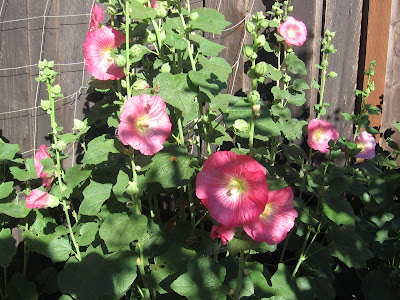
It took about five years to get from the first planting out of seeds for the dramatic Italian climbing squash, Trombetta di Albenga, to actually featuring some in a meal.
Year 1: Discover a packet of Renee's Garden seeds at a local drugstore. Plant some out of curiosity. Become so intimidated by the gargantuan plants and strange elongated fruit that none of them get used for food. Forget about it for a couple of years.
Year 4: Find the old seed packet with some seeds left in it. Plant some out of curiosity, wondering if they will grow. They do. Vow that this time the squash will make it into a meal.
It doesn't. Vow not to plant Trombetta di Albenga again.
Year 5: Discover some seedlings of Zucchetta Rampicante at a local nursury. Plant some out of curiosity. Find out that Zucchetta Rampicante is Trombetta di Albenga by another name, or such a close cousin that there is no discernible difference: long thick vines twining up eight foot poles and across a trellis, bearing numerous sleek green fruit that dangle in mid-air as they grow larger and longer. Give up, accept the dictates of fate, and welcome Zucchetta/Trombetta into our family cuisine.
Most of this year's harvest found its way into the summer batches of green soup. But finally, in early December, we used the last tender squash in a delicious frittata. The recipe comes from the attractive Italian food blog,
Not Only Pizza. The secret to getting the best flavor is to slice the squash into thin rounds or half circles.

Another secret is to use really good cheese, such as Asiago. Here's the recipe:
Frittata with trombetta di Albenga
(From notonlypizza.com)
Ingredients:
1 lb. trombetta di Albenga
2 cloves of garlic
7-8 datterino tomatoes or cherry quartered or cut in half
3-4 fresh basil leaves
4 eggs
1/2 cup shredded provolone, scamorza (not smoked), Asiago or a cheese of your choice
2 Tbsp. extra virgin olive oil
sea salt to taste
Preparation:
Slice the trombetta thinly with a knife or a mandoline. Heat up 1 Tablespoon oil in a nonstick skillet with 2 cloves of garlic. Add the squash and cook it until tender, about 15 minutes mixing it often.
When the squash is cooked, turn it off and add the tomatoes. This is already a good side dish.
To make the frittata, eliminate the cloves of garlic, put the cooked squash in a bowl, add the basil, the eggs, the shredded cheese and a good pinch of salt. Mix well.
Heat up 1 Tablespoon olive oil in a non-stick skillet and pour the zucchini-egg mixture. Cook at low medium heat for about 10-15 minutes uncovered or until the bottom becomes golden brown.
Place a large plate over the frittata and turn the pan upside down then slide the frittata back in the pan and cook it for other 10 more minutes. Serve it warm or tepid, it’s good either way.

Here's what the squash looked like in late September, still sizing up on the vine.

And here's how it appeared on our dinner table at last!
(Full disclosure: It turns out that another really important secret for a perfect frittata is to use a non-stick pan so the whole thing doesn't fall apart when it gets flipped over. But that's just a minor detail in the long saga of Trombetta di Albenga, which is not only abundant but really quite delicious.)





















































